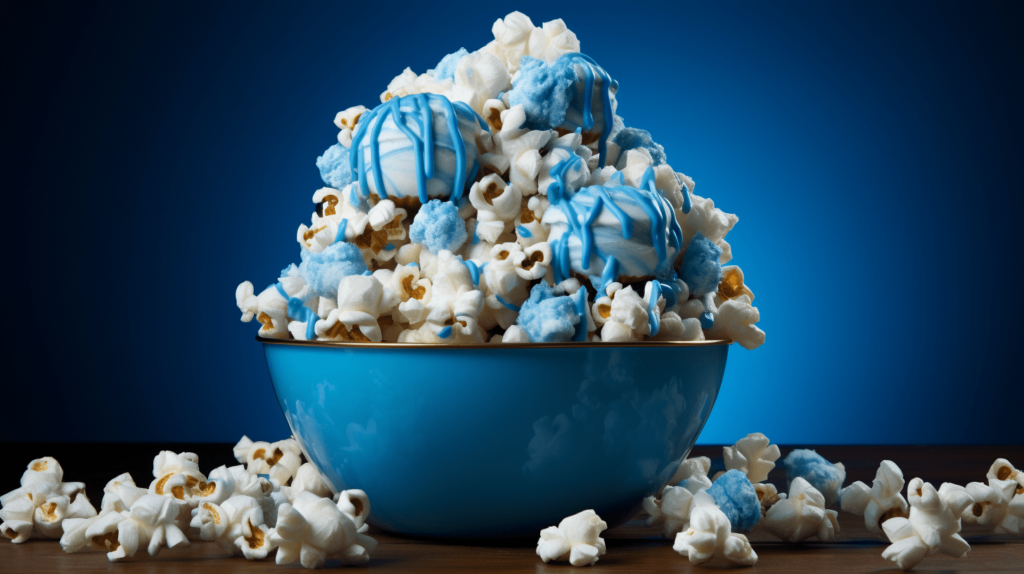Get ready to experience the allure of blue popcorn, a visually captivating alternative to artificially dyed varieties. While it may seem like a whimsical treat, there’s more to blue popcorn than meets the eye.
This comprehensive guide delves into the unique nutritional benefits, distinct taste and texture, and the best methods for popping this extraordinary snack.
But beware, not all blue popcorn is created equal. Join us as we uncover everything you need to know about this natural and visually appealing delight.
Key Takeaways
- Blue popcorn is typically identified by its natural midnight blue color, and some companies use artificial dyes to profit more.
- Blue popcorn has higher protein and lower starch content than other types of popcorn, and it also has higher antioxidant content due to anthocyanins.
- Blue popcorn has a sweeter and nuttier taste than white and yellow corn, and it doesn’t require a lot of extra flavor from toppings.
- Blue popcorn can be made using the same methods as other types of popcorn, but it requires a higher temperature to pop effectively.
Blue Popcorn Varieties and Ingredients
One important consideration when discussing blue popcorn varieties and ingredients is the potential health risks associated with artificial dyes. Some companies choose to use artificial dyes, such as Blue 1 Lake, to enhance the color of their popcorn and make it more visually appealing.
However, these artificial dyes have been linked to various health concerns. Studies have shown that some artificial dyes can cause allergic reactions, hyperactivity in children, and even animal cancer.
Therefore, checking the ingredients label when purchasing blue popcorn is crucial, and opt for varieties that do not contain artificial dyes. By choosing natural blue popcorn or those colored with natural ingredients like butterfly pea flower extract, consumers can enjoy the vibrant color without compromising their health.
Nutritional Benefits of Blue Popcorn
Blue popcorn stands out among other varieties for its higher protein and lower starch content, making it a nutritious option for health-conscious individuals.
- Nutritional Benefits:
- Blue popcorn has a higher protein content compared to other types of popcorn.
- Blue popcorn has lower starch content compared to other types of popcorn.
- Health Benefits:
- Blue popcorn has a higher antioxidant content due to anthocyanins.
- Blue popcorn falls lower on the glycemic index, resulting in a lower blood sugar spike.
These nutritional benefits make blue popcorn an excellent choice for those looking to increase their protein intake while keeping their starch intake low. Additionally, the higher antioxidant content in blue popcorn provides health benefits such as memory improvement and protection against diabetes. Its lower glycemic index also makes it a suitable option for individuals who need to manage their blood sugar levels.

Taste and Texture of Blue Popcorn
The taste and texture of blue popcorn differ from other varieties, offering a sweeter and nuttier flavor that pairs perfectly with its hearty crunch. Blue popcorn has a distinct taste sets it apart from traditional white and yellow corn. While it still tastes like popcorn, blue popcorn has a more nuanced difference that adds a unique twist to this beloved snack.
The sweetness and nuttiness of blue popcorn make it stand out, and it doesn’t require a lot of extra flavor from toppings to enhance its taste. Additionally, blue popcorn is slightly smaller than other types of popcorn, and its hearty texture provides a satisfying crunch. Blue popcorn is a delicious and satisfying snack, whether enjoyed plain or with a sprinkle of salt.
Making Blue Corn Popcorn
To effectively make blue corn popcorn, it is essential to ensure that the kernels are heated at a higher temperature than other popcorn types. This higher temperature is necessary to fully pop the blue corn kernels and achieve the desired fluffy texture.
Here are some critical steps to follow when making blue corn popcorn:
- Use a stovetop method: The stovetop method is the most efficient way to pop blue corn popcorn. It allows for better heat control and ensures that the kernels are evenly heated.
- Purchase plain blue popcorn kernels: To maintain the natural sweetness and avoid artificial additives, it is recommended to choose plain blue popcorn kernels. This will result in a more authentic and healthier popcorn experience.
Health Risks of Artificial Dyes in Blue Popcorn
Artificial dyes in blue popcorn pose potential health risks due to their use of additives and preservatives.
While blue popcorn can be an attractive and visually appealing snack, it is essential to be aware of the ingredients used in its production. Some companies may use artificial dyes, such as Blue 1 Lake, to achieve the desired blue color, but these additives can adversely affect health.
Artificial dyes have been linked to various health issues, including hyperactivity in children, allergic reactions, and even certain types of cancer. To mitigate these risks, it is essential to check the ingredients label and opt for blue popcorn varieties that do not contain artificial dyes.
Choosing Plain Blue Popcorn Kernels
When selecting plain blue popcorn kernels, consider their natural color and ensure they do not contain artificial dyes. Blue popcorn is known for its distinctive midnight blue color, naturally occurring in certain varieties. However, some companies use artificial dyes, such as Blue 1 Lake, to enhance the color and profit more significantly. These artificial dyes can have health risks, so checking the ingredients label before purchasing blue popcorn kernels is essential.
To make an informed choice, here are two key factors to consider:
- Natural color: Look for blue popcorn kernels with a deep blue hue. This indicates that the color is derived from corn and not artificial additives.
- Absence of artificial dyes: Make sure the packaging explicitly states that the blue popcorn kernels do not contain any artificial dyes. This ensures that you are consuming a product free from potentially harmful additives.
Unique Features of Blue Popcorn
With its distinct midnight blue color and sweeter flavor, blue popcorn is often considered a rare treat enjoyed occasionally at special events or movie nights. This unique variety of popcorn stands out from the traditional white and yellow popcorn due to its vibrant blue hue, which is naturally derived from anthocyanins.
Not only does blue popcorn offer a visually appealing alternative to artificially dyed popcorn, but it also has a range of unique features. Its taste is sweeter and nuttier, making it a delightful snack without additional toppings. Additionally, blue popcorn has higher protein content, lower starch content, and higher antioxidant levels, providing potential health benefits such as memory improvement and protection against diabetes.
When choosing blue popcorn, opting for plain kernels to avoid artificial additives commonly found in microwave varieties is essential.
Blue popcorn offers a unique snacking experience with its distinctive color, flavor, and nutritional profile.
Popping Blue Popcorn: Tips and Techniques
To achieve optimal popping results, mastering the technique of heating the kernels at a higher temperature is crucial when making blue popcorn. Here are some tips and techniques to help you achieve the perfect batch:
- Preheat your pot or pan on medium-high heat before adding the kernels.
- Use a small amount of oil with a high smoke point, such as coconut or avocado.
- Add a few test kernels to gauge the temperature. Once they start popping, remove them from the pan.
- Add the remaining blue popcorn kernels and cover the pot with a tight-fitting lid.
- Shake the pot gently back and forth to ensure even heating and prevent burning.
Listen for the sound of popping to slow down. This indicates that most of the kernels have popped.
- Remove the pot from heat and let it sit for a minute to allow any remaining kernels to pop.
- Carefully remove the lid, keeping it away from your face to avoid steam burns.
- Transfer the popped blue popcorn to a bowl, season as desired, and enjoy!
With these techniques, you can make a delicious and perfectly popped batch of blue popcorn every time.
Blue Popcorn: A Natural and Visually Appealing Snack Option
Consumers are increasingly drawn to the natural and visually appealing snack option of blue popcorn, which stands out for its unique color and health benefits.
Blue popcorn, with its natural midnight blue color, is a popular choice for those looking for a fun and visually striking snack. Unlike artificially dyed popcorn, blue popcorn is typically made using natural color from blue corn kernels. This makes it a healthier option, as artificial dyes can have potential health risks.
In addition to its unique color, blue popcorn also offers several health benefits. It has a higher protein content than other popcorn types, lower starch, and higher antioxidant content due to anthocyanins. Blue popcorn also falls lower on the glycemic index, resulting in a lower blood sugar spike.
Blue popcorn provides a natural and visually appealing alternative to artificially dyed popcorn, making it a popular choice among health-conscious consumers.
Conclusion
In conclusion, blue popcorn offers a visually captivating and naturally derived alternative to artificially dyed popcorn. Its unique nutritional profile, distinct taste, and hearty texture make it an attractive snack.
By carefully examining the ingredients label and choosing plain blue popcorn kernels, individuals can avoid the health risks associated with artificial dyes.
So why settle for ordinary popcorn when you can enjoy the visually appealing and healthier choice of blue popcorn?



